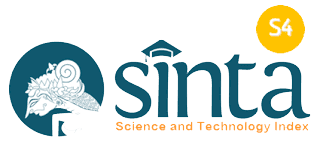Comparative Study of the Use of Objective Tests and T essays D in Improving Achievement Learning Indonesian Language
(1) STIMIK Jakarta STI&K, of Jakarta, Indonesia
(2) University Pamulang. Of Tangerang Selatan, Banaten, Indonesia.
(*) Corresponding Author
DOI: https://doi.org/10.26858/pdr.v5i2.32434
Abstract
Educational institutions in Indonesia , so Indonesian is included as one of the fields of study that is taught from elementary school to university, so that the success of its teaching will determine its further development. To find out success can be done in various ways, including through assessment or evaluation activities, both orally and in writing. In general, what teachers do at school is a written test consisting of an objective test and an essay test. The population taken in this study were students of class s XI AK and class XI TKJ. The data collection technique used is the experimental method and the test method, because basically this research will compare two forms of objective tests and essay tests for class XI students of SMK Gita Kirtti I Jakarta. While other methods are helpful. The hypothesis in this research is that learning achievement in Indonesian using objective tests is better than those using essay tests for class XI students at SMK Gita Kirtti I Jakarta for the 2020/2021 academic year. Analysis of the data used is statistical processing techniques, using the t test formula. After the two data obtained are entered into the formula, it can be seen that to = 3.037 with a significance level of 5% t table = 2.093. Meanwhile, with a significance level of 1% t table = 2.861. This means that to is greater than t table, so the hypothesis can be accepted. Thus, it can be concluded that learning achievement in the field of Indonesian language studies by evaluating the form of an objective test is better than the evaluation of the form of an essay test for class XI students of SMK Gita Kirtti I Jakarta.
Keywords
Full Text:
PDFReferences
Abdullah, A., & ZA, T. (2018). Orientation of Education in Shaping the Intellectual Intelligence of Children. Advanced Science Letters, 24(11), 8200–8204.
Attri, P., Bhatia, R., Gaur, J., Arora, B., Gupta, A., Kumar, N., & Choi, E. H. (2017). Triethylammonium acetate ionic liquid assisted one-pot synthesis of dihydropyrimidinones and evaluation of their antioxidant and antibacterial activities. Arabian Journal of chemistry, 10(2), 206–214.
Bordes, A., Boureau, Y.-L., & Weston, J. (2016). Learning end-to-end goal-oriented dialog. arXiv preprint arXiv:1605.07683.
Brinson, J. R. (2015). Learning outcome achievement in non-traditional (virtual and remote) versus traditional (hands-on) laboratories: A review of the empirical research. Computers & Education, 87, 218–237.
Butler, J. M., Anderson, K. A., Supiano, M. A., & Weir, C. R. (2017). “It feels like a lot of extra work”: resident attitudes about quality improvement and implications for an effective learning health care system. Academic Medicine, 92(7), 984–990.
Darling-Hammond, L. (2015). The flat world and education: How America’s commitment to equity will determine our future. Teachers College Press.
Dhawan, S. (2020). Online learning: A panacea in the time of COVID-19 crisis. Journal of Educational Technology Systems, 49(1), 5–22.
Haberman, M. (2010). The pedagogy of poverty versus good teaching. Phi delta kappan, 92(2), 81–87.
Hasnidar, H., Sulihin, S., & Elihami, E. (2020). Developing of multiple intelligences in students with the two stay two strays type. Edumaspul: Jurnal Pendidikan, 4(2), 7–12.
Hirst, P. H. (2010). Knowledge and the curriculum: A collection of philosophical papers. Routledge.
Jaber, M. Y., & Khan, M. (2010). Managing yield by lot splitting in a serial production line with learning, rework and scrap. International Journal of Production Economics, 124(1), 32–39.
Kosciw, J. G., Greytak, E. A., Bartkiewicz, M. J., Boesen, M. J., & Palmer, N. A. (2012). The 2011 National School Climate Survey: The experiences of lesbian, gay, bisexual and transgender youth in our nation’s schools. ERIC.
Laurence, D. R., & Bacharach, A. L. (2013). Evaluation of drug activities: pharmacometrics. Elsevier.
Mansir, F., & Karim, A. (2020). Islamic education learning approaches in shaping students’ emotional intelligence in the digital age. Hayula: Indonesian Journal of Multidisciplinary Islamic Studies, 4(1), 67–86.
Mishra, L., Gupta, T., & Shree, A. (2020). Online teaching-learning in higher education during lockdown period of COVID-19 pandemic. International Journal of Educational Research Open, 1, 100012.
Nain, U. (2020). The Supra-Village Goverment’s Elite Domination in Village Development Planning in Bulukumba South Sulawesi Indonesia.
Nain, U., & Agustang, A. (2020). Analysis On The Utilization Of Village Funds In Cash For Work Program In Bulukumba Regency, South Sulawesi Indonesia. International Journal of Advanced Science and Technology, 29(7s), 2811–2818.
Nikolic, S., Suesse, T., Jovanovic, K., & Stanisavljevic, Z. (2020). Laboratory learning objectives measurement: Relationships between student evaluation scores and perceived learning. IEEE Transactions on Education, 64(2), 163–171.
Rao, V. K., Chhikara, B. S., Shirazi, A. N., Tiwari, R., Parang, K., & Kumar, A. (2011). 3-Substitued indoles: one-pot synthesis and evaluation of anticancer and Src kinase inhibitory activities. Bioorganic & medicinal chemistry letters, 21(12), 3511–3514.
Spronken-Smith, R., Walker, R., Batchelor, J., O’Steen, B., & Angelo, T. (2012). Evaluating student perceptions of learning processes and intended learning outcomes under inquiry approaches. Assessment & Evaluation in Higher Education, 37(1), 57–72.
Sutrisno, S., Abidin, A. Z., Winata, H., Harjianto, P., & Sunarsi, D. (2020). Penyuluhan Pengelolaan Keuangan Sederhana Siswa SMA 6 Tangerang Selatan. BAKTIMAS: Jurnal Pengabdian pada Masyarakat, 2(1), 67–71.
Tao, B., Díaz, V., & Guerra, Y. (2019). Artificial intelligence and education, challenges and disadvantages for the teacher. Arctic Journal, 72(12), 30–50.
Vural, O. F. (2013). The Impact of a Question-Embedded Video-Based Learning Tool on E-Learning. Educational Sciences: Theory and Practice, 13(2), 1315–1323.
Yang, F., Li, F. W. B., & Lau, R. W. H. (2010). An open model for learning path construction. International Conference on Web-Based Learning, 318–328.
Article Metrics
Abstract view : 413 times | PDF view : 36 timesRefbacks
- There are currently no refbacks.
Copyright (c) 2022 Sutarno Sutarno, Sri Purni Hernawati


































